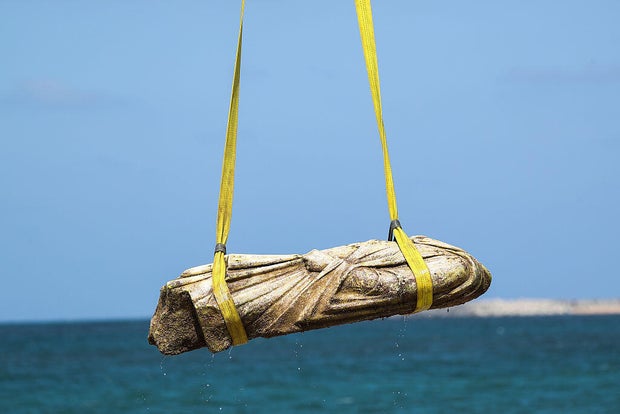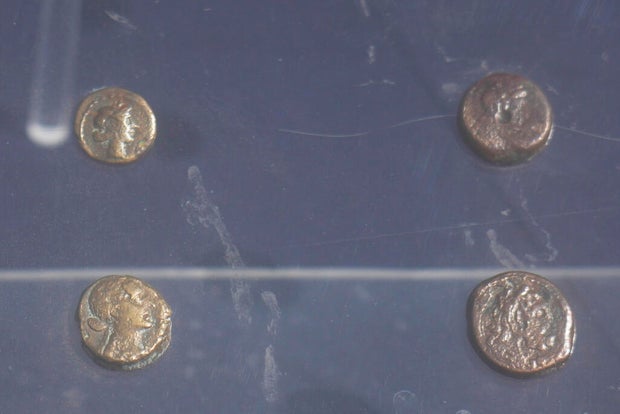Historic statues, Roman cash and different artifacts from a sunken metropolis had been pulled from the Mediterranean Sea off the coast of Egypt Thursday.
The relics date again over 2,000 years. Egyptian authorities mentioned the positioning, situated within the waters of Abu Qir Bay close to Alexandria, could also be an extension of the traditional metropolis of Canopus, a distinguished heart throughout the Ptolemaic dynasty, which dominated Egypt for almost 300 years, and the Roman Empire, which ruled for round 600 years.
Over time, a sequence of earthquakes and rising sea ranges submerged the town and the close by port metropolis of Thonis-Heracleion, abandoning a treasure trove of historic stays.
Khaled Desouki/AFP through Getty Pictures
On Thursday, cranes slowly hoisted statues from the depths, whereas divers in wetsuits, who had helped retrieve them, cheered from the shore.
“There’s loads underwater, however what we’re in a position to deliver up is restricted, it is solely particular materials in keeping with strict standards,” Egyptian Tourism and Antiquities Minister Sherif Fathi mentioned. “The remaining will stay a part of our sunken heritage.”
Gehad Hamdy/image alliance through Getty Pictures
The underwater ruins revealed by the ministry on Thursday embody limestone buildings that will have served as locations of worship, residential areas and business or industrial constructions.
Reservoirs and rock-carved ponds for home water storage and fish cultivation had been additionally uncovered.
Different notable finds had been statues of royal figures and sphinxes from the pre-Roman period, together with {a partially} preserved sphinx with the cartouche of Ramses II, one of many nation’s most well-known and longest-ruling historic pharaohs.
Gehad Hamdy/image alliance through Getty Pictures
Lots of the statues are lacking physique components, together with a beheaded Ptolemaic determine product of granite, and the decrease half of a Roman nobleman’s likeness carved from marble.
A service provider ship, stone anchors and a harbour crane relationship again to the Ptolemaic and Roman eras had been discovered on the web site of a 125-metre dock, which the ministry mentioned was used as a harbour for small boats till the Byzantine interval.
Amr Nabil / AP
Abu Qir Bay gained historic significance in 1859 when Egyptian Prince Oma Touson, together with fishermen and divers, discovered stays of historic constructions, in keeping with Egypt’s Ministry of Tourism and Antiquities.
Along with the sunken cities, a number of shipwrecks have been discovered within the bay. The ships embody the wreckage of Napolean’s fleet from the 1798 Battle of the Nile, the ministry mentioned. Napolean’s French fleet was defeated by a British fleet.
Khaled Desouki/AFP through Getty Pictures
At the moment, Alexandria is liable to succumbing to the identical waters that claimed Canopus and Thonis-Heracleion.
The coastal metropolis is very susceptible to local weather change and rising sea ranges, sinking by greater than three millimeters yearly.
Even within the United Nations’ best-case state of affairs, a 3rd of Alexandria will likely be underwater or uninhabitable by 2050.













